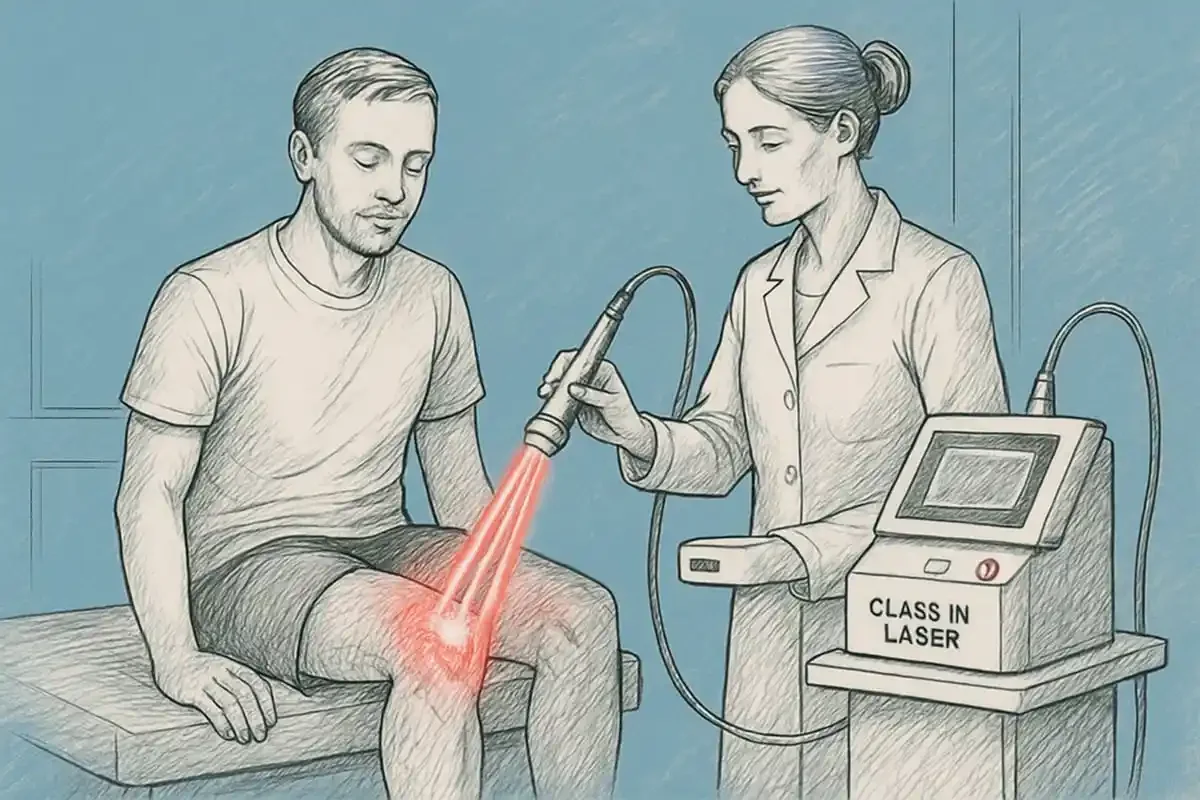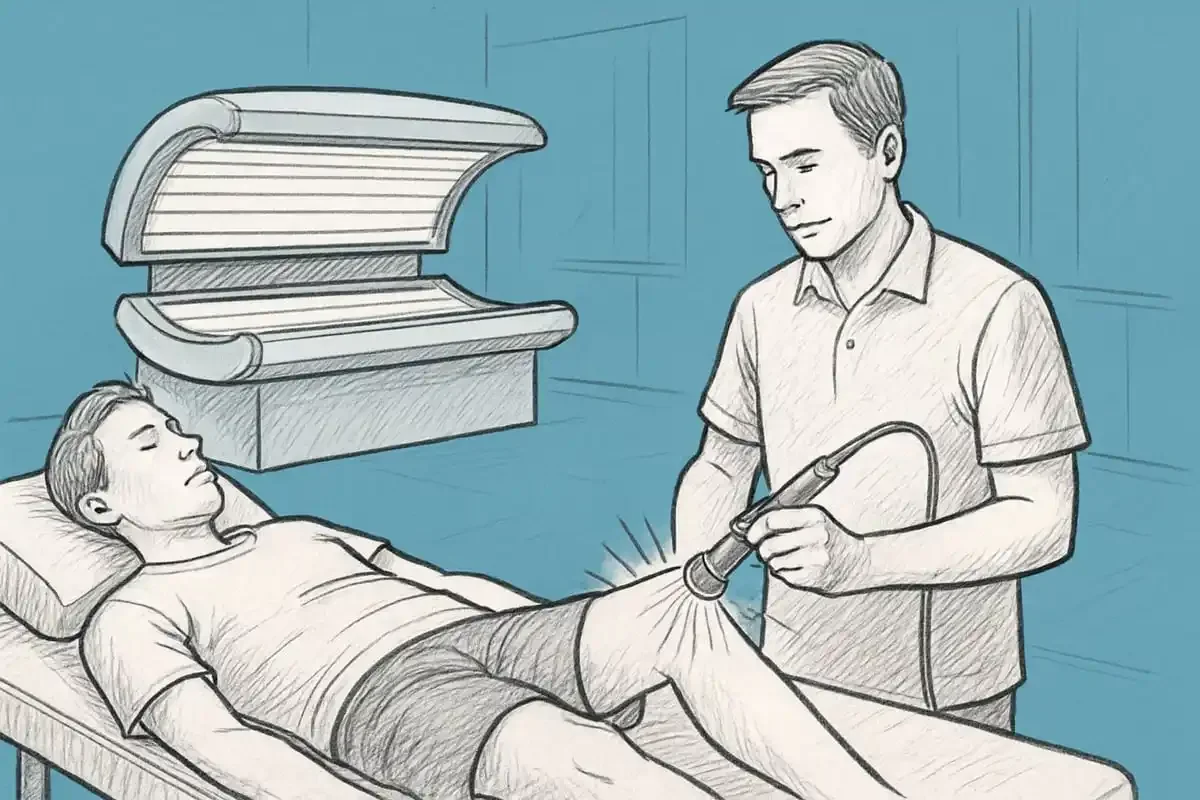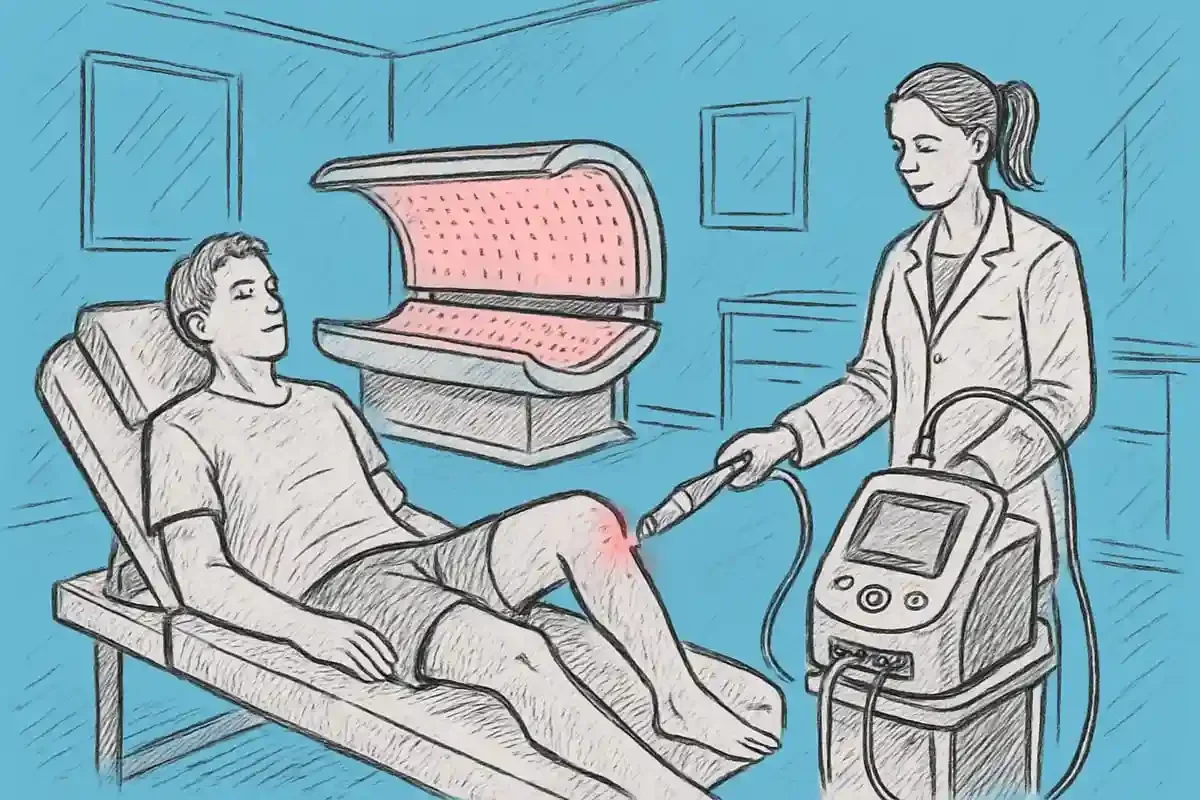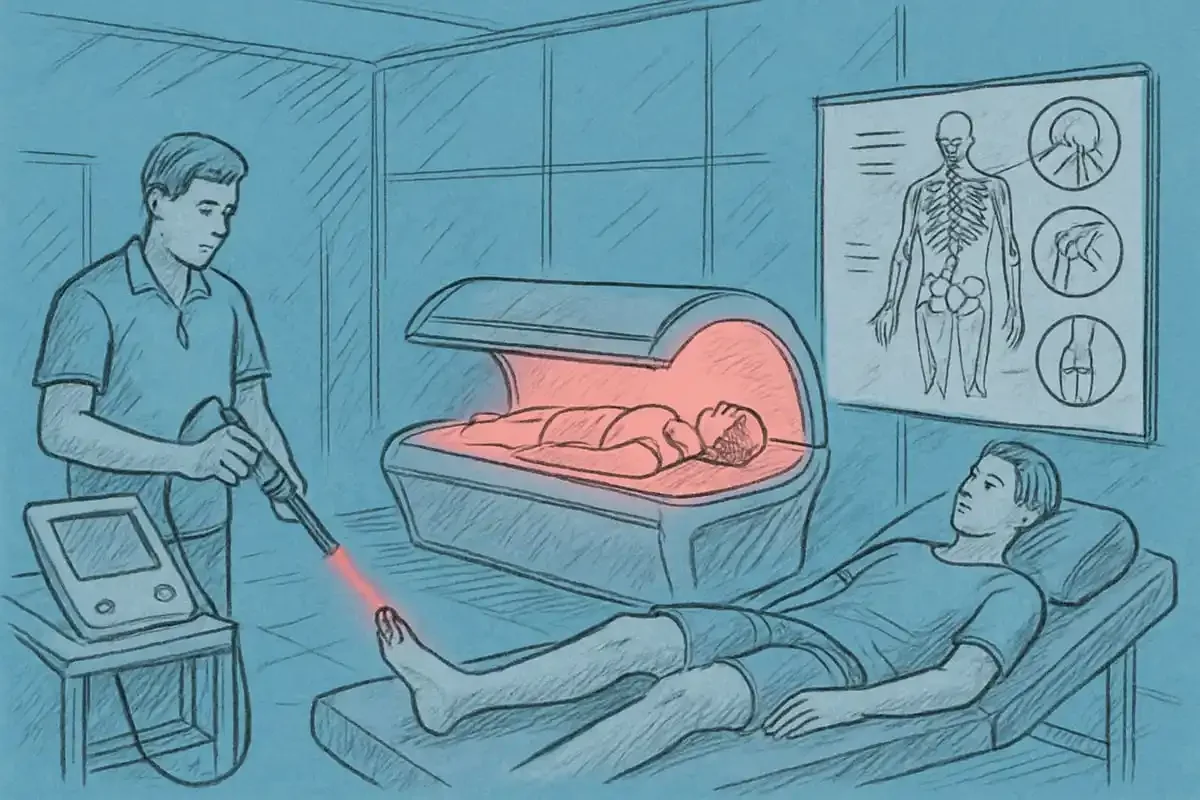Photobiomodulation Guide: Benefits, Uses, and Insights 2025
Imagine recovering from injuries faster and with less pain through the power of light. In 2025, photobiomodulation is transforming how we approach musculoskeletal injury management, using targeted light therapy for deep healing and regeneration.
At Mountain Health and Performance, we have embraced this innovation with our state-of-the-art class 4 laser therapy unit. This advanced device offers non-invasive support for muscle strains, joint pain, and more, helping patients return to activity sooner.
Looking ahead, we are excited to soon introduce a full-body red light bed. This next wave of technology will be available for use on its own or combined with other therapies, offering even broader benefits for your health and recovery.
Curious about how these advances could support your wellness journey? Read on to explore the science, benefits, and future of photobiomodulation.
Understanding Photobiomodulation: Science and Mechanisms
Photobiomodulation is reshaping the way we approach healing, especially for musculoskeletal injuries. This section dives into the science behind photobiomodulation, how it works at the cellular level, the types of technology used, and the key safety considerations. Whether you are curious about the history of PBM or want to know how Mountain Health and Performance is staying at the forefront, you’ll find clarity here.
What is Photobiomodulation?
Photobiomodulation is a form of light therapy that uses low-level lasers, higher intensity (Class 4) lasers, or LEDs to stimulate healing and reduce inflammation. Unlike even higher-intensity laser treatments that cut or burn tissue, photobiomodulation works painlessly on the surface and below, making it ideal for managing musculoskeletal injuries.
Historically, NASA and Hungarian physician Endre Mester played pivotal roles in PBM’s development. NASA first used light therapy to accelerate wound healing in space, while Mester’s research established foundational principles for its application on Earth.
You may hear PBM referred to as low-level laser therapy (LLLT), red or near-infrared light therapy.
How PBM Works at the Cellular Level
At its core, photobiomodulation harnesses specific wavelengths of light, typically between 600 and 1100 nm, to interact with chromophores in your cells. The primary target is cytochrome c oxidase in the mitochondria, the cell’s energy powerhouse. When these chromophores absorb light, mitochondrial activity increases and more ATP, the body’s energy currency, is produced.
This cellular energy boost leads to several healing effects. In musculoskeletal injury management, PBM helps modulate reactive oxygen species (ROS), reducing oxidative stress and inflammation. It also alters gene expression to support cell proliferation and tissue differentiation, vital for recovery from sprains, strains, and overuse injuries.
For instance, studies show that PBM can stimulate osteoblast activity, accelerating bone repair after fractures or dental implants. This is why clinics like Mountain Health and Performance use photobiomodulation to help patients recover from tendon injuries, muscle tears, or post-surgical procedures.
The following table summarizes key effects of photobiomodulation on cellular health:
Mechanism / Impact on Healing
ATP Production / Increases energy for repair
ROS Modulation / Reduces inflammation
Gene Expression / Promotes cell growth and renewal
Stem Cell Activation / Supports tissue regeneration
Red and near-infrared wavelengths are most studied for their depth of penetration and effectiveness. This makes photobiomodulation a powerful ally in restoring function and speeding up recovery in musculoskeletal cases.
Types of Devices and Light Sources
Photobiomodulation can be delivered using a range of devices, most often low-level lasers or LEDs. The main differences lie in their output, treatment depth, and clinical application. Low-level lasers provide focused, coherent light suitable for deeper tissues, while LEDs are effective for surface treatments and larger areas.
Mountain Health and Performance utilizes a Class IV laser therapy unit, which offers higher power and deeper tissue penetration than low level laser units, making it especially effective for stubborn musculoskeletal injuries. Class IV lasers are distinguished from Class III devices by their output strength, enabling clinicians to tailor treatment intensity for each patient’s needs.
Treatment parameters include wavelength, power density, pulse structure, and session duration.
As technology advances, the next wave includes full-body red light beds. These innovative devices deliver uniform photobiomodulation to the entire body, supporting systemic recovery and overall wellness. Mountain Health and Performance will soon offer a full-body red light bed, available both as a standalone therapy and in combination with other treatments, expanding options for patients seeking cutting-edge care.
For a deeper dive into the science and devices behind PBM, check out this therapeutic laser treatment overview.
Safety Profile and Contraindications
One of the reasons photobiomodulation is gaining popularity is its strong safety profile. Treatments are non-invasive and typically cause only minor side effects, such as mild redness or temporary irritation at the application site.
However, there are important contraindications. Photobiomodulation should be avoided over cancerous lesions, in individuals taking medications making the light-sensitive, over the low back and belly of pregnant patients, and near the eyes. Proper device calibration and adherence to safety protocols are crucial for minimizing risk.
Regulatory bodies like the FDA and Health Canada have approved many PBM devices, ensuring they meet strict standards for clinical use. Clinics should use certified equipment, and practitioners must be trained in safe and effective application. Mountain Health and Performance follows these guidelines, prioritizing patient safety while leveraging the latest advancements in photobiomodulation therapy.
Proven Benefits of Photobiomodulation
Photobiomodulation is transforming the landscape of injury management, pain relief, and recovery for 2025. Its benefits extend from reducing discomfort to boosting tissue repair, making it a cornerstone in musculoskeletal and wellness care. Clinics like Mountain Health and Performance are leading the way, offering advanced Class 4 laser therapy units and soon, innovative full-body red light beds. Let’s explore the proven benefits of photobiomodulation across key areas, with a special focus on musculoskeletal health.
Pain Relief and Inflammation Reduction
One of the most celebrated benefits of photobiomodulation is its ability to ease pain and lower inflammation, especially in musculoskeletal injuries. PBM works by modulating inflammatory mediators, such as prostaglandin E2, helping to reduce swelling and tenderness in affected tissues.
Clinical research consistently demonstrates PBM’s effectiveness for musculoskeletal pain, arthritis, and nerve-related discomfort. For instance, patients with chronic tendinopathy, low back pain, and osteoarthritis often report significant improvements after PBM treatments.
Mountain Health and Performance utilizes a Class 4 laser therapy unit, which delivers higher power for deeper penetration into large muscle groups and joints. This technology is ideal for athletes and active individuals seeking rapid relief from acute or chronic pain. For a deeper dive into clinical evidence and use cases, explore their Photobiomodulation therapy articles.
Accelerated Healing and Tissue Repair
Photobiomodulation is widely recognized for speeding up tissue repair and recovery after injuries or surgery. By promoting collagen synthesis and encouraging new blood vessel growth, PBM helps wounds and soft tissue injuries heal faster.
Clinical trials show that PBM can accelerate healing rates by 30 to 50 percent in cases such as diabetic ulcers and surgical incisions. This makes it a go-to therapy for post-operative care, sports injuries, and chronic wounds.
Mountain Health and Performance’s Class 4 laser therapy is frequently used for these applications, ensuring targeted delivery of energy to deep tissues. The next wave of innovation is on the horizon: full-body red light beds, which will soon be available at the clinic. These beds offer comprehensive tissue support and can be used alone or alongside Class 4 laser treatments for enhanced results.
Enhanced Cellular Function and Regeneration
Beyond pain and healing, photobiomodulation plays a key role in cellular function and regeneration. PBM stimulates the proliferation and differentiation of stem cells, which is crucial for repairing bones, tendons, and other connective tissues.
By boosting cellular energy production and promoting healthy gene expression, PBM helps the body recover from injury on a fundamental level. This is especially valuable for complex musculoskeletal cases where regeneration is essential.
Neurological and Cognitive Benefits
Photobiomodulation extends its benefits to neurological and cognitive health. Studies indicate that PBM reduces neuroinflammation and can offer neuroprotection following traumatic brain injuries or strokes.
Early clinical evidence suggests improvements in memory, mood, and attention for patients with mild traumatic brain injuries or cognitive decline. These findings are generating excitement for future applications in neurorehabilitation and mental health.
As technology advances, clinics are exploring how PBM can be integrated with other neurological therapies, offering hope for patients seeking non-invasive recovery options.
Immune System Modulation and Other Benefits
The impact of photobiomodulation on the immune system is gaining recognition, especially for chronic inflammatory and dermatological conditions. PBM has been used to treat psoriasis, acne, and eczema by modulating immune responses.
With the introduction of full-body red light beds at Mountain Health and Performance, clients will have new options for whole-body immune support and skin health, expanding the reach of photobiomodulation in daily wellness.
Clinical and At-Home Uses of PBM in 2025
Photobiomodulation is rapidly transforming how clinicians and consumers approach healing, pain management, and recovery. In 2025, the versatility of this therapy is on full display, with both clinical and at-home solutions becoming more accessible and advanced.
Whether you are seeking relief from a musculoskeletal injury or looking to enhance athletic recovery, photobiomodulation offers a science-backed, non-invasive option. Let us explore the diverse ways this technology is used today and what exciting innovations are on the horizon.
Medical and Rehabilitation Applications
In clinical settings, photobiomodulation is a cornerstone for managing musculoskeletal injuries. It is used in chiropractic and physical therapy to accelerate muscle, tendon, and ligament recovery, reduce inflammation, and alleviate pain. Dentists also employ PBM for oral lesions, periodontitis, and post-extraction healing, while dermatologists use it for wound care and skin rejuvenation.
Mountain Health and Performance stands at the forefront by offering a Class 4 laser therapy unit. Class 4 lasers deliver higher power and deeper tissue penetration, making them ideal for stubborn injuries like plantar fasciitis, tendonitis, and chronic low back pain. This approach enables faster, more effective recovery compared to lower-output devices.
Sports Medicine and Athletic Recovery
Athletes are embracing photobiomodulation to speed up muscle recovery, enhance performance, and prevent injuries. PBM is especially valuable after intense training or competition, reducing muscle soreness and shortening the time needed to return to play.
Elite sports teams and individual athletes alike turn to PBM for its ability to support tissue repair and reduce inflammation without medication. At Mountain Health and Performance, sports injury protocols often combine PBM with other modalities, maximizing results for both acute and chronic conditions.
With the upcoming introduction of full-body red light beds, athletes will soon have access to even broader recovery options, targeting large muscle groups and systemic fatigue in a single session.
Neurological and Mental Health Applications
Photobiomodulation is gaining attention for its role in neurological and mental health. Early studies show PBM can support recovery from Seasonal Affective Disorder and improve sleep quality.
Transcranial PBM, where light is applied to the scalp, is being studied for its effects on mood and attention. Results so far suggest improved outcomes, especially in mild cognitive impairment and post-concussion care. Clinics like Mountain Health and Performance are closely monitoring these developments, aiming to integrate new protocols as evidence grows.
Veterinary and Non-Human Use Cases
The benefits of photobiomodulation are not limited to humans. Veterinary practices are now using PBM for equine tendon injuries, canine arthritis, and post-surgical wound healing in pets. Animals respond well to PBM, often showing reduced pain and faster mobility restoration.
For example, dogs recovering from orthopedic surgery may receive PBM to help tissue repair and minimize swelling. The non-invasive nature of PBM makes it a safe and effective option for animal care, mirroring many of the advantages seen in human medicine.
At-Home Devices: What to Know
Consumer access to photobiomodulation is expanding with the rise of at-home devices. Options range from handheld wands to large LED panels and facial masks, allowing users to address pain, inflammation, and skin concerns from the comfort of home.
When selecting an at-home PBM device, it is crucial to consider quality, safety certifications, and manufacturer guidelines. Look for devices with clear wavelength specifications and approval from regulatory bodies. At-home PBM can be effective for mild to moderate issues, but severe or persistent conditions should be assessed by a professional.
Mountain Health and Performance will soon offer a state-of-the-art full-body red light bed, giving clients the opportunity to experience the latest in at-home and clinical PBM technology.
Choosing the Right PBM Therapy
With so many options, choosing the right photobiomodulation therapy depends on your goals, the type of injury or condition, and the expertise of your provider. Clinical-grade lasers, like the Class 4 unit at Mountain Health and Performance, are best for deep tissue injuries and chronic pain, while at-home panels work well for surface-level concerns.
Individualized protocols are essential for optimal results. Your provider should tailor wavelength, dosage, and session frequency to your specific needs. Whether you are seeking recovery from a musculoskeletal injury or aiming to boost overall wellness, consult with a knowledgeable clinic to ensure safe and effective use of PBM.
Key Insights and Emerging Trends in PBM for 2025
In 2025, photobiomodulation is rapidly evolving, particularly in musculoskeletal injury management. Clinicians and patients alike are seeing new technologies and protocols that are reshaping how recovery, pain relief, and tissue repair are approached. Mountain Health and Performance stands at the forefront, providing access to advanced tools and preparing to introduce even more innovative solutions in the coming months.
Advances in PBM Technology
The landscape of photobiomodulation technology is changing quickly, especially for musculoskeletal injury management. Clinics are now utilizing high-powered Class 4 laser therapy units, which can penetrate deeper tissues and accelerate healing. At Mountain Health and Performance, the Class 4 laser therapy unit is a cornerstone of care for tendon, ligament, and muscle injuries. For a deeper dive into how these lasers are transforming outcomes, see their Shockwave and Class IV laser therapy article.
The next wave includes wearable PBM devices. Full-body red light beds are also gaining attention for their potential to address widespread pain and inflammation. Mountain Health and Performance will soon offer a state-of-the-art full-body red light bed, available as a standalone treatment or in combination with other modalities.
Class 4 laser therapy for deep tissue repair
Wearable PBM and smart patches
Full-body red light beds for systemic benefits
This evolving toolkit is making photobiomodulation more accessible and effective for a wider range of injuries.
Expanding Research and Evidence Base
The research behind photobiomodulation continues to grow, with new clinical trials and meta-analyses supporting its use in musculoskeletal injury management. Recent studies have explored its effectiveness in conditions like tendonitis, muscle strains, and joint inflammation, showing promising results for faster recovery and reduced pain.
There is also a surge in research on photobiomodulation for neurodegenerative diseases and autoimmune conditions, but its role in physical rehabilitation is especially robust. Ongoing studies highlight improved muscle function and decreased downtime after injury, which is key for athletes and active individuals.
Meta-analyses confirm pain reduction and faster healing
Ongoing trials in sports medicine and chronic injury
Evidence base expanding for both clinical and at-home devices
As the science matures, evidence-based protocols are becoming the standard, ensuring photobiomodulation remains a trusted tool in injury management.
Personalized PBM Protocols
Personalization is a major trend in photobiomodulation for 2025. Providers are now tailoring wavelength, dose, and session frequency based on individual needs, injury type, and skin type.
For musculoskeletal injuries, this means that therapy can be fine-tuned to the tissue type and stage of healing
This personalized approach leads to better outcomes and higher patient satisfaction, making photobiomodulation more effective than ever.
Regulatory and Safety Developments
As photobiomodulation devices become more powerful and widely available, regulatory bodies are updating standards to ensure safety and efficacy. In 2025, there is a strong emphasis on practitioner training, device calibration, and clear usage guidelines.
Mountain Health and Performance uses only certified devices and trained clinicians, ensuring treatments are safe for musculoskeletal injury patients. Stricter device certifications and comprehensive safety protocols are now required in many regions.
Updated FDA and Health Canada regulations
Mandatory practitioner education programs
Enhanced device certification processes
These changes protect patients and help maintain the clinical integrity of photobiomodulation therapies.
Integration with Other Therapies
A key trend in 2025 is the integration of photobiomodulation with other evidence-based therapies. Combining PBM with physical therapy, shockwave, or regenerative medicine can amplify results for musculoskeletal injuries. Mountain Health and Performance is preparing to offer a full-body red light bed, which can be used alone or in synergy with manual therapy and exercise programs.
PBM as an adjunct to physical therapy and rehabilitation
Enhanced outcomes when combined with shockwave or stem cell therapies
Flexible protocols for individualized care
This collaborative approach maximizes the benefits of photobiomodulation and ensures comprehensive recovery strategies for patients.
How to Get Started with Photobiomodulation: Step-by-Step Guide
Ready to experience the benefits of photobiomodulation for musculoskeletal health? Follow this simple guide to begin your journey, whether you’re recovering from injury, looking to optimize performance, or simply curious about the latest wellness technology.
Step 1: Assess Your Health Goals and Needs
Start by identifying what you hope to achieve with photobiomodulation. Are you managing a recent sports injury, chronic pain, or looking for faster muscle recovery? PBM excels in musculoskeletal injury management, supporting healing and reducing inflammation.
Discuss your goals with a healthcare provider familiar with photobiomodulation. At Mountain Health and Performance, practitioners help pinpoint if PBM fits your needs, whether it’s acute injury support or ongoing wellness.
Step 2: Choose the Appropriate PBM Modality
Next, decide which type of photobiomodulation therapy matches your goals. Clinical treatments, like those using a class 4 laser at Mountain Health and Performance, deliver targeted power for deeper tissues, making them ideal for significant musculoskeletal injuries.
At-home devices, such as red light panels, are great for surface-level issues or maintenance. The next wave of innovation includes full-body red light beds, soon available at Mountain Health and Performance, offering comprehensive exposure for whole-body recovery or as an adjunct to other therapies.
Step 3: Select a Qualified Provider or Device
Choosing the right provider or device is key for safe and effective photobiomodulation. Look for clinics with advanced equipment, like Mountain Health and Performance’s class 4 laser therapy unit, and staff trained in musculoskeletal protocols.
If considering at-home use, research devices with proper certifications and clinical backing. Always verify regulatory approvals, such as FDA or Health Canada certification, and ask about the provider’s experience with your specific concerns.
Step 4: Understand Treatment Protocols and Expectations
Before starting photobiomodulation, learn what to expect during sessions. Most treatments for musculoskeletal injuries last 10 to 20 minutes, with a gentle warmth but no pain.
Protocols may vary, so your provider will tailor session frequency and duration to your unique needs. For example, acute injuries might require more frequent sessions at first, while ongoing maintenance could mean fewer visits as healing progresses.
Step 5: Monitor Progress and Adjust as Needed
Track your symptoms and progress as you undergo photobiomodulation. Use pain scales or mobility assessments to note improvements in movement or comfort.
Communicate regularly with your provider to adjust protocols if needed. Mountain Health and Performance emphasizes personalized care, ensuring your musculoskeletal recovery stays on track and that you get the most from each session.
Step 6: Maintain Safety and Best Practices
Follow all safety guidelines for photobiomodulation, including proper eye protection and adherence to session limits. Avoid using PBM over areas that are contraindicated, such as directly on the eyes or over cancerous lesions.
Your provider will ensure equipment is calibrated and protocols are safe, especially when using higher-powered devices like class 4 lasers for musculoskeletal applications.
Step 7: Stay Informed on PBM Advances
Keep up with new developments in photobiomodulation, as the field is rapidly evolving. Mountain Health and Performance is at the forefront, soon offering cutting-edge full-body red light bed therapy for enhanced musculoskeletal recovery.
To stay ahead of trends and market growth, you can also review resources like the PBM Therapy Market Analysis 2025-2032 for insights into emerging technologies and industry leaders.
Frequently Asked Questions About Photobiomodulation
Curious about photobiomodulation and how it fits into modern health and injury recovery? This FAQ will shed light on the essentials, especially if you’re considering this therapy for musculoskeletal injuries at Mountain Health and Performance. Let’s get your questions answered.
Is PBM Safe and Are There Side Effects?
Photobiomodulation stands out for its safety profile, especially when managed by trained professionals. Sessions are nonpainful, and often described as pleasant or relaxing. Some might notice mild redness or a warm sensation, but adverse effects are rare.
Safety is enhanced by using certified devices and following established protocols. At Mountain Health and Performance, treatments use a class 4 laser therapy unit, which is calibrated for both effectiveness and safety. However, photobiomodulation is not suitable for everyone. Pregnant individuals, those with cancerous lesions, or anyone with certain eye conditions should consult a healthcare provider before starting therapy.
How Soon Can I Expect Results?
The timeline for results with photobiomodulation varies based on the condition and treatment area. For musculoskeletal injuries, such as sprains or strains, some patients feel pain relief after just one or two sessions. More complex tissue repair, like tendon or ligament healing, may take several weeks of regular treatment.
Factors influencing speed include the severity of the injury, the type of device used, and individual response. Mountain Health and Performance’s class 4 laser can accelerate recovery, especially when combined with other rehabilitation techniques. Consistency is key for optimal outcomes with photobiomodulation.
Can PBM Be Used with Other Treatments?
Absolutely. Photobiomodulation is often combined with physical therapy, manual therapy, and even medications. This approach can enhance overall recovery and reduce reliance on painkillers. For athletes, PBM can be integrated with strength training and mobility work for faster return to play.
Emerging research highlights PBM’s positive impact on sports performance and recovery. For a deeper dive into these benefits, see this PBM Effects on Sports Performance literature review. At Mountain Health and Performance, your care plan may include PBM alongside other innovative therapies, maximizing results for musculoskeletal injuries.
What Conditions Are Best Treated with PBM?
Photobiomodulation is well-supported for a range of musculoskeletal conditions. These include acute injuries like muscle strains, chronic pain such as tendonitis, and even post-surgical recovery. It is also effective for arthritis, back pain, and joint inflammation.
The class 4 laser therapy at Mountain Health and Performance is designed for deep tissue penetration, making it ideal for stubborn or recurring injuries. With the next wave of technology, such as full-body red light beds, even more comprehensive treatment options will soon be available for both injury management and overall wellness.
How Do I Choose a Reputable PBM Provider or Device?
Selecting the right provider or device is crucial for safe and effective photobiomodulation. Look for clinics with certified practitioners and devices that meet regulatory standards. At Mountain Health and Performance, all equipment, including the class 4 laser and soon-to-arrive full-body red light bed, is approved and maintained to the highest standards.
Tips for choosing wisely:
Check provider credentials and training.
Ensure devices have FDA or Health Canada certification.
Ask about personalized protocols for your condition.
Seek clinics that offer a range of PBM options for different needs.
Now that you’ve seen how photobiomodulation can transform pain relief and recovery, it makes sense to work with professionals who really get how your body heals. At Mountain Health and Performance in North Vancouver, our experienced chiropractors use the latest science to help you address musculoskeletal issues, whether you’re struggling with an injury or just want to move better every day. If you’re curious about how cutting edge therapies fit into your personal wellness journey, let’s take that next step together—Book with one of our chiropractors today.




